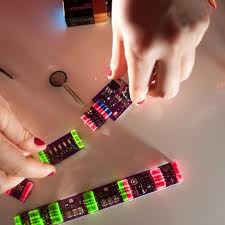
AUGUST 2012: Is littleBits a toy, a learning kit, or an innovation tool? Well, it looks like a toy but if it is making it to the ‘top’ lists of CNN, Popular Science, Forbes and the like, apart from getting Series A investment from top venture capitalists and forging a unique partnership with manufacturing and supply chain management leader PCH to produce littleBits as part of their Accelerator program, then it must be a lot more than a toy!
So, what really is littleBits?
It is an attempt to make electronics easy and fun for everybody to understand and do. Founder Ayah Bdeir was kind of irked by the fact that much of today’s electronics is becoming a black box for commoners, it is something they switch on, to handle a function, and switch off once the job is done. What is inside, how does it work? It is not that nobody is interested. It is just that it is too scary for them to comprehend. Although words like circuit, solder and program might seem simple for many of our readers, it is still Greek and Latin to many. How do you make electronics less formidable for these masses? That was what led to the making of littleBits.
Just for the sake of a comparison, we could say littleBits is to electronics what Lego is to mechanics. littleBits consists of tiny modules, each of which can do some simple task like buzz, light up or sense something. The modules include almost all basic electronic components’ pulses, motors, thresholds, whatever you can think of. There are over 50 basic modules including input, output and power components. These modules can snap together where you place them using wee little magnets. No need to solder or paste anything. You can reuse, reorganise, recreate and make a lot of things with a single kit.
You can use littleBits to put together various components and understand how different electronics devices work, or for prototyping new ideas–which makes it a veritable innovation tool. Why not use it to add a bit of jazz to model homes and toys as well? At the world-renowned Marker Faire held in San Francisco, in May 2012, the littleBits team demonstrated so many beautiful ideas–toys with lights and buzzers, smart home models, and even an igloo with polar bear sensors.
Innovation, the open source way
If more people understand electronics, more people will have more ideas, and there will be lots more innovation. That happens to be the main motive behind littleBits because the team has consciously made the entire effort open source, including the website that is licensed under Creative Commons. All the modules are open source and the circuit diagrams can be freely downloaded from their website. There is a thriving online community that discusses ideas about what to make with littleBits, as also a community that dreams up new components and kits.
Indeed, you can use littleBits to come up with your own new ideas and prototype them. The team also hopes that it will add more power to electronics design because you have a live, working model as a design tool. You can rip it up, put it together in different ways and visualise your ideas much better.
In short, it is something that is making big labs, media giants and renowned universities pay attention. The huge scope of littleBits makes it more than a toy–many are beholding it as a new technology that will empower the coming generations to innovate with electronics.
Some modules and kits are now available for purchase. You can check their website for more details littlebits.cc/. Very soon, PCH will make sure littleBits floods the markets!





